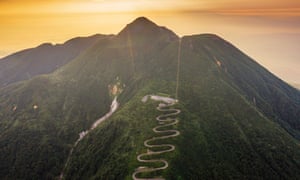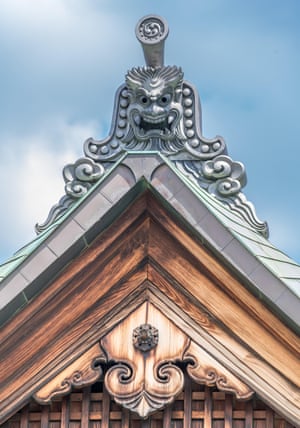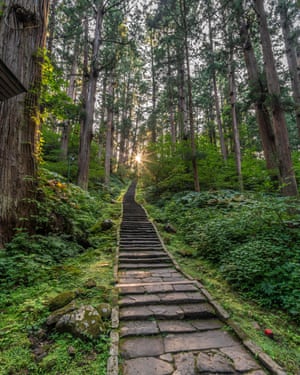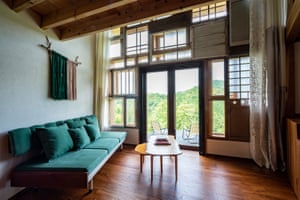Kayabuki class and winter canoeing: a guide to sustainable travel in Japan
The Roots sustainability programme teaches conventional constructing strategies.
Photograph: Yuri Kobayashi
Learn conventional constructing strategies in the Keihoku mountains, Kyoto
Based in the bucolic, mountainous Keihoku space in north-west Kyoto, the Roots sustainability programme presents multi-day instructional excursions to teams, with an emphasis on connecting to nature, sustainability, and immersion in native tradition.
Each bespoke tour is structured round a central venture and interspersed with different (non-compulsory) experiences akin to mountaineering, rice planting and craft workshop visits. You would possibly, as an example, be taught the artwork of kayabuki (thatching with pampas grass) from an knowledgeable, course of typhoon-damaged timber in a cedar forest, and then construct a treehouse below the steerage of a native lumberjack, carpenter and treehouse “master”. These crafts have been given a increase by the truth that conventional Japanese kominka structure belatedly gained Unesco Intangible Cultural Heritage standing in December 2020.
From £914pp from six nights primarily based on a group of 15–24. rootsjourney.jp
Observe the Japanese large salamander in Nichinan, Tottori
Called Ōsanshōuo, or “giant pepper fish” in its native Japan, the Japanese large salamander is among the world’s largest amphibians. This aquatic, nocturnal “living fossil” can be in hazard of extinction.
On this wildlife conservation expertise, company accompany main Japanese large salamander knowledgeable Dr Sumio Okada into the forests of Daisen-Oki National Park. Wading knee-deep in crystal-clear rivers, you’ll help in measuring and weighing salamanders in their pure habitat, and assist report this information. Data generated helps enrich present analysis on Andrias japonicus, and the tour value additionally contains a donation in direction of the native large salamander conservation group.
From £494pp. bushidojapan.com/japanese-giant-salamander

Follow in Basho’s footsteps by way of northern Japan – on two wheels
Put a totally different spin on haiku poet Basho’s narrow road to the deep north by biking it. On the Trans-Tohoku bike tour operated by Nasu-based Bicycle Tours Japan, company traverse the 900km route from Tochigi to Aomori over 12 days and 11 nights. Expect few automobiles, gorgeous landscapes, day by day crash programs in regional delicacies, loads of sake and scorching baths each evening.
Though e-bikes can be found if required, that is strictly for these with biking expertise, as you’ll want to have the ability to cowl 70–110km per day over mountainous terrain. However, a assist van means you may travel gentle and deal with pedalling (and consuming) – and even skip a number of the steeper hills, if vital.
To take a totally different route northward, and see how Honshu’s north-eastern shoreline is recovering from the consequences of the 2011 earthquake and tsunami, you may hike a part – or all, in case you have two months to spare – of the Michinoku Coastal Trail. Hefty chunks of the trail meander by way of the Sanriku Fukko (Reconstruction) nationwide park, which was created in 2013 to kickstart ecotourism in the realm and was lastly opened in 2019. This yr marks 10 years for the reason that Great East Japan Earthquake, so it’s an particularly poignant time to go to the area, which is able to commemorate the anniversary with a year-long programme of memorial ceremonies.
From £3,193pp for 3 or extra individuals. bicycle-tours.jp/54

Meet one of many final onigawara roof tile artisans in Sakamoto, Shiga
Shiga prefecture is usually overshadowed by neighbouring Kyoto, however the experiences provided by the entirely women-operated Tour du lac Biwa greater than maintain their very own in opposition to the historic metropolis. Their small group excursions happen across the west aspect of Lake Biwa, with actions starting from a conventional tea ceremony to walking in the Hiei mountains with a living Buddha.
A specific spotlight is the chance to visit one of the last onigawara (demon roof tile) workshops in Japan. You’ll achieve a deeper appreciation for the sheer labour and artistry concerned in these hand-carved creations, and temple and shrine roofs won’t ever look the identical once more! A should for Japanese structure lovers.
From £120pp for a group of two–3. lacbiwa.com
Harvest tea and greens at a farmstay in Kawane Honcho, Shizuoka
Nestled in the misty mountains of rural Shizuoka, the tiny agricultural city of Kawane Honcho produces a few of Japan’s best inexperienced tea. Stay with one of many native farming households and share in their lives: get up early to harvest tea or bamboo shoots in spring, make your individual noodles, or simply unwind in the encircling forests. Whoever you stick with, the meals will probably be distinctive. Don’t neglect to e-book a lunch at Acai, a vegan restaurant set in a cosy, gorgeously refurbished farmhouse.
Rates fluctuate by keep and expertise. Contact Kawane Green Tourism to e-book. shizuoka-escape.com
Make washi paper and moss balls in Saji-cho, Tottori
For the common metropolis dweller, few rural homestays get extra distant than these in Tottori, most well-known for its sand dunes and being the least-populated Japanese prefecture. Learn the ins and outs of nation dwelling at one in all Saji-cho’s 40+ homestays, the place you would possibly make your individual paper or moss balls, domesticate mushrooms, climb waterfalls, or prepare dinner dinner over a wood-fired range. As a bonus, Tottori is among the greatest locations in Japan for stargazing.
Rates fluctuate. Contact Goshinosato Saji Regional Council to e-book. saji-5shi.jp/en

Forage for wild greens and prepare dinner shojin ryori on Mount Haguro, Yamagata
Though the prevalence of dashi means Japanese delicacies isn’t normally vegan-friendly, shojin ryori (Buddhist temple vegetarian delicacies) is a main exception. Let the guides at Yamagata tour specialist Hidden Japan take you on a journey into the forests of Mount Haguro, the place you’ll first be taught to determine and harvest wild mountain greens (or mushrooms in autumn) alongside yamabushi monks. Afterwards, head again to Miyatabo Lodge and prepare dinner up an elaborate vegan feast.
From £212pp. thehiddenjapan.com
Experience Mount Fuji as sacred cultural heritage in Fujinomiya, Shizuoka
Climbing to the summit of Mount Fuji is a in style travel bucket listing exercise, as evidenced by the busy trails in summer time. But En-Ya Mt. Fuji Ecotours takes a totally different (and much less strenuous) strategy by as an alternative encouraging you to see the mountain as a sacred, religious web site. Guests start with a shrine go to, adopted by a light hike to the Hoei crater, earlier than returning to downtown Fujinomiya through the Mount Fuji fifth station.
Staffed solely by native Fujinomiya residents, En-Ya additionally runs excursions incorporating, variously, biking by way of Shiraito Natural Park, tea tasting, sweets-making, kimono rental, and a go to to a conventional sake brewery. Guests staying at their non-public glamping web site Satoyama Vacation, which has a splendid view of Mt. Fuji, get a free tour included with their lodging price.
From £128pp, minimal 2 company. mtfujiecotours.com
Hike by way of the mountains of Hokkaido
Ramble, scramble, bike or hike the mountains of Japan’s northernmost prefecture with the pleasant “100% raised in Hokkaido” guides at Adventure Hokkaido, whose dedication to sustainable tourism shines by way of, significantly in their close relationships with indigenous Ainu groups. You’ll expertise the good outside, but in addition study native ecology, Ainu tradition, and Hokkaido’s colonial historical past.
Choose your route in accordance to expertise and health ranges. Inveterate hikers will love the week-long tour around Daisetsuzan National Park; alternatively, the day tour of Mount Arashiyama and Asahikawa Ainu Museum is a good mix of historical past, tradition, meals and strolling.
Rates fluctuate by tour. adventure-hokkaido.com/guided-tours

Live the zero-waste life in Kamikatsu, Tokushima
With its forward-looking zero-waste policies, the village of Kamikatsu on Shikoku Island is Japan’s poster little one for the sustainability motion. Many go to to observe the “gomi station” (the native waste-separation centre), the place garbage is sorted into 45 classes, or examine in at zero-waste WHY, the place a extra formal studying programme is integrated into your resort keep.
More immersive nonetheless, maybe, is the Inow programme, on which you’ll reside like a Kamikatsu native for 2 weeks. This means recycling like a native, but in addition volunteering on the gomi station and studying homestyle cooking on the zero-waste enterprise Cafe Polestar. No two programmes are alike; relying on the season and availability, you’ll have the ability to attempt your hand at indigo-dyeing, tea harvesting and natural farming. Two weeks will zip by in a flash.
From £781pp for 14 days. inowkamikatsu.com
Canoe throughout Lake Towada in the depths of winter, Aomori
While Japan is hottest as a spring/autumn travel vacation spot, visiting off-peak is a method to assist counter the consequences of overtourism. Try this various to snowboarding or snowboarding: winter canoeing throughout a glassy, cobalt blue caldera lake.
Towada Guidehouse Kai operates winter canoeing tours in Towada-Hachimantai National Park’s Lake Towada. Experienced skilled guides will aid you practise the mandatory paddling strategies prior to setting off. En route, they’ll determine and educate you about surrounding wildlife – black kites, grebes, cormorants – and take you to a cove accessible solely by canoe.
From £77pp for a group of two or extra. Japanese-language web site, however an English-speaking guide is accessible. Contact through e-mail to e-book. tgkai.jp/index.html
For extra Japan-based experiences, itineraries, journeys and suggestions, go to Japan National Tourism Organization: japan.travel




